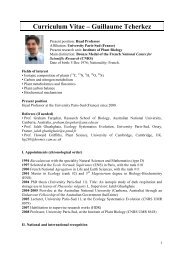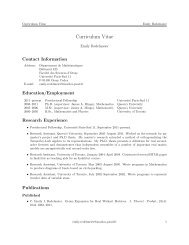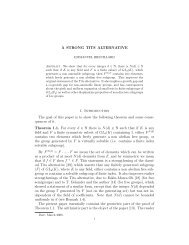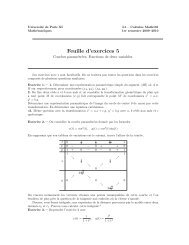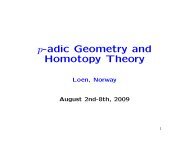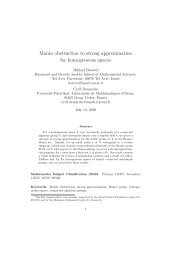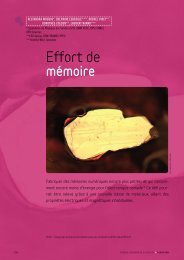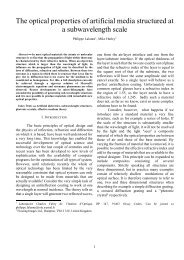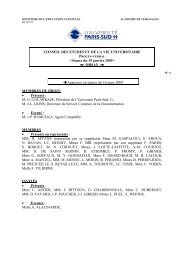Birational invariants, purity and the Gersten conjecture Lectures at ...
Birational invariants, purity and the Gersten conjecture Lectures at ...
Birational invariants, purity and the Gersten conjecture Lectures at ...
You also want an ePaper? Increase the reach of your titles
YUMPU automatically turns print PDFs into web optimized ePapers that Google loves.
50<br />
§ 5 Back to <strong>the</strong> <strong>Gersten</strong> <strong>conjecture</strong><br />
As already mentioned in § 2.2.3 <strong>and</strong> § 3.7, in 1980, Ojanguren [Oj80] proved th<strong>at</strong> <strong>the</strong><br />
Witt group of a local ring of a smooth variety over a field injects into <strong>the</strong> Witt group<br />
of its field of fractions. In 1989, Ojanguren <strong>and</strong> I [CT/Oj92] axiom<strong>at</strong>ized Ojanguren’s<br />
method. We were thus able to prove injectivity, in <strong>the</strong> sense of § 2.1, for various functors.<br />
In this section I will describe <strong>the</strong> method (§ 5.1) <strong>and</strong> give a few more injectivity results<br />
(§ 5.2). We shall actually prove injectivity results “with parameters”, i.e. for functors on<br />
<strong>the</strong> c<strong>at</strong>egory of k-algebras, of <strong>the</strong> shape A ↦−→ F (Z × k A), where Z/k is a fixed k-variety.<br />
Based on one such an injectivity result for <strong>the</strong> Chow groups, in § 5.3 we shall give a new<br />
proof of a codimension one <strong>purity</strong> <strong>the</strong>orem due to M. Rost.<br />
§ 5.1 A general formalism<br />
Let k be a field <strong>and</strong> F be a covariant functor A ↦−→ F (A) from <strong>the</strong> c<strong>at</strong>egory of<br />
noe<strong>the</strong>rian k-algebras (not necessarily of finite type), with morphisms <strong>the</strong> fl<strong>at</strong> homomorphisms<br />
of rings, to <strong>the</strong> c<strong>at</strong>egory of pointed sets, i.e. sets equipped with a distinguished<br />
element. The distinguished element in F (A) shall be denoted 1 A , <strong>and</strong> often simply 1.<br />
Given A → B, <strong>the</strong> kernel of F (A) → F (B) is <strong>the</strong> set of elements of F (A) whose image is<br />
1 B . Consider <strong>the</strong> following properties.<br />
A1. F commutes with filtering direct limits of rings (with fl<strong>at</strong> transition homomorphisms).<br />
A2. Weak homotopy : for all fields L containing k, <strong>and</strong> for all n ≥ 0, <strong>the</strong> map<br />
has trivial kernel. (i.e. kernel reduced to 1).<br />
F (L[t 1 , . . . , t n ]) −→ F (L(t 1 , . . . , t n ))<br />
A3. P<strong>at</strong>ching : Given an étale inclusion of integral k–algebras A → B <strong>and</strong> given a<br />
non-zero element f ∈ A such th<strong>at</strong> <strong>the</strong> induced map A/f −→ B/f is an isomorphism, <strong>the</strong><br />
induced map on kernels<br />
is onto.<br />
Ker[F (A) → F (A f )] −→ Ker[F (B) → F (B f )]<br />
THEOREM 5.1.1 ([CT/Oj92]). — Let k be an infinite field. Assume th<strong>at</strong> F s<strong>at</strong>isfies A1,<br />
A2 <strong>and</strong> A3. If L ⊃ k <strong>and</strong> A is a local ring of a smooth L-variety, with fraction field K,<br />
<strong>the</strong>n<br />
ker[F (A) −→ F (K A )] = 1 .<br />
Proof :



